Last updated on
Hiding pipes in your basement can remarkably enhance its aesthetic appeal, because creative concealment methods offer both practical and decorative benefits.
Dealing with exposed pipes in your basement can be an aesthetic challenge, but there are several creative ways to hide or disguise them that can seamlessly integrate into your home decor.
Whether you choose to paint them, box them in, or use decorative covers, the key is to incorporate these elements into the overall design of your space.
This article will delve into these ideas and more, providing detailed steps and considerations to help you achieve a polished and cohesive look in your basement, no matter the size or layout of your pipes.
Table of Contents
Ceiling Boxing
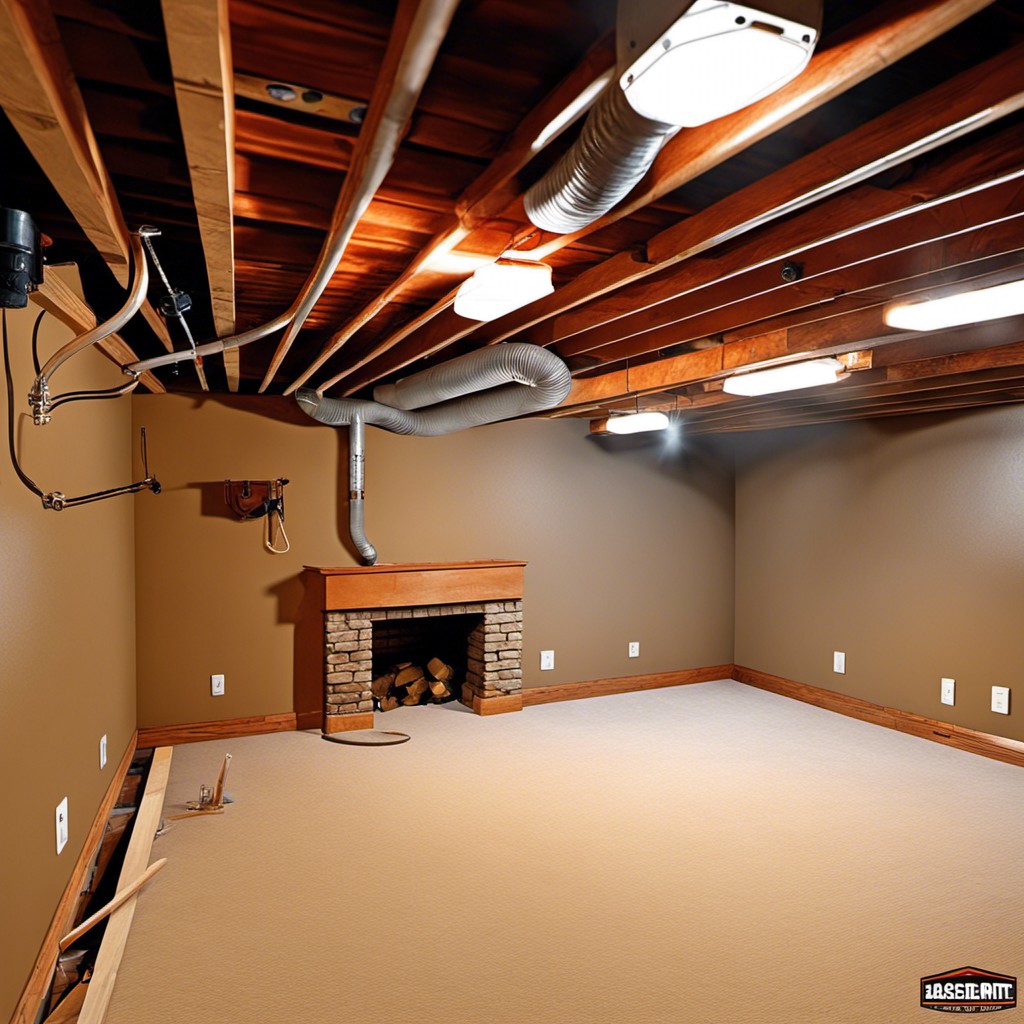
Capitalizing on structure to conceal unwanted pipes, ceiling boxing is a smart and stylish solution. Constructed from drywall or timber, these box-like structures can blanket multiple pipes, creating a clean, minimalist aesthetic for your basement.
1. Versatility – Ceiling boxing accommodates different pipe orientations, working horizontally or vertically.
2. Customizable Design – Tailor its shape and size to suit the space – ensuring a seamless integration.
3. Accessibility – Including removable panels, allows for the inevitable maintenance and repairs.
4. Sound Insulation – It also contributes to noise reduction, enhancing the overall feel of your basement.
5. Upgrade – A fresh coat of paint or wallpaper transforms this functional necessity into an attractive feature.
Remember, the right placement of ceiling boxing not only hides the pipes but also adds a stylish accent wall or ceiling to your basement.
False Walls
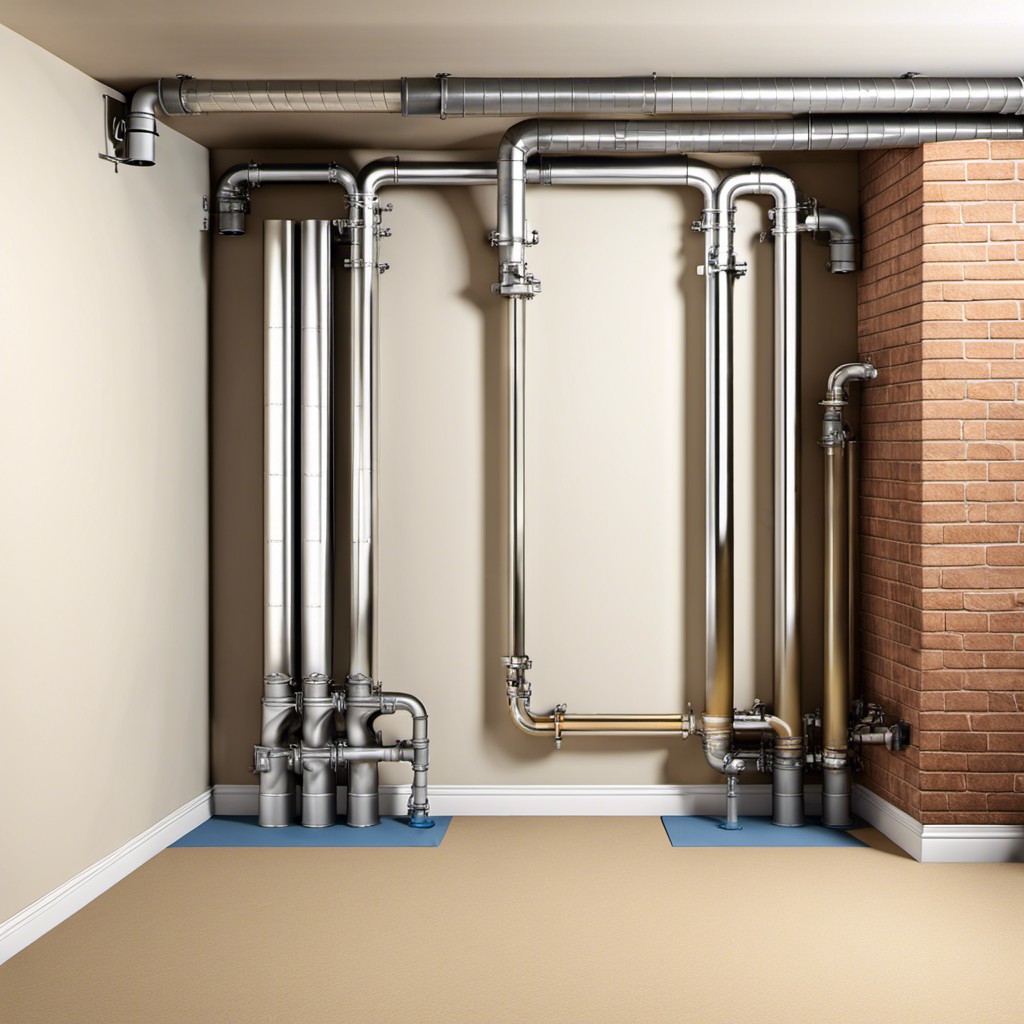
False walls offer an excellent workaround for unsightly basement pipes. They provide a seamless cover-up, maintaining the aesthetics of your finished basement. Here are the steps to create a false wall effectively.
First, measure the area where the false wall will be installed. Proper measurements help ensure the wall fits well, providing a neat finish. Second, construct the wall frame from wood or metal, ensuring to leave enough space to accommodate the piping. Then, install the wall frame, fixing it securely to the floor and ceiling.
Third, apply drywall or paneling to the frame. This covers the pipes and provides a canvas that can be painted or wallpapered to match the rest of your basement. Remember, access panels can be installed for areas that may need future maintenance.
Lastly, decorate your new wall. You can hang artwork, family photos, or other decor to add personal touches. The false wall not only hides pipes but also adds character to your basement.
With this technique, you can hide pipes, wiring and ductwork, transforming your basement into a comfortable living space with ease.
Drop Down Ceilings
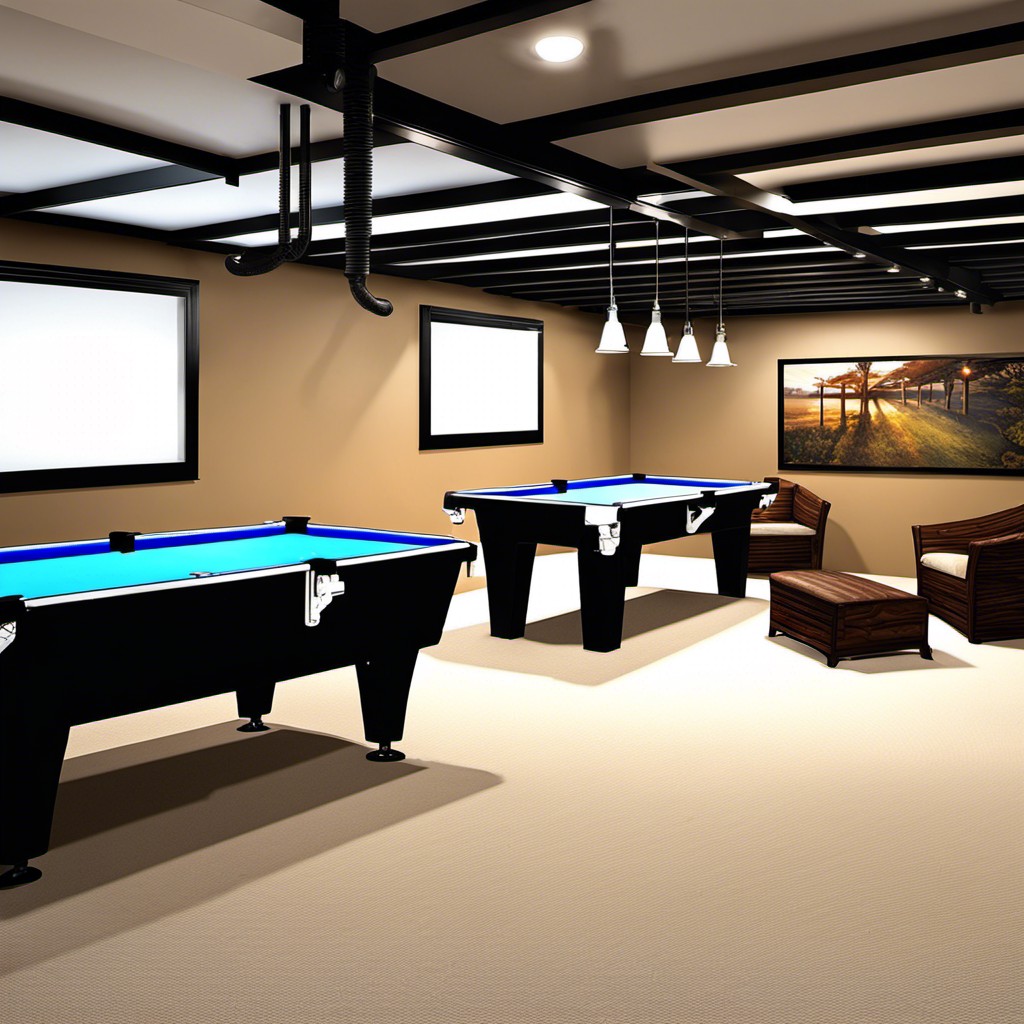
By introducing a lower layer beneath the existing structure, a drop-down ceiling offers an attractive way to conceal piping. This option often uses hanging grids where square or rectangular panels rest, creating an organized, checkerboard-like finish. These panels can be removed easily, providing convenient access to the concealed pipes, in case of maintenance or repair.
Here are few major points to consider:
- Variety of Designs: With a wide array of textures, colors, and materials available, they can complement your basement’s decor seamlessly. From wood grain to mineral fiber, the possibilities are significant.
- Sound Absorption: Besides aesthetics, these ceilings can enhance a room’s acoustics by absorbing noises, reducing echo, and providing a more comfortable living environment.
- Easy Installation: Generally, drop-down ceilings are easier to install compared to other methods and don’t require much experience or specialized tools.
- Light Fitting: You can comfortably fit recessed light fixtures in these ceilings, thus contributing to a warm and inviting atmosphere.
Having said these, note that this option may reduce room height. Therefore, it’s crucial to analyze your basement’s spatial dimensions prior to choosing this method.
SoFit System
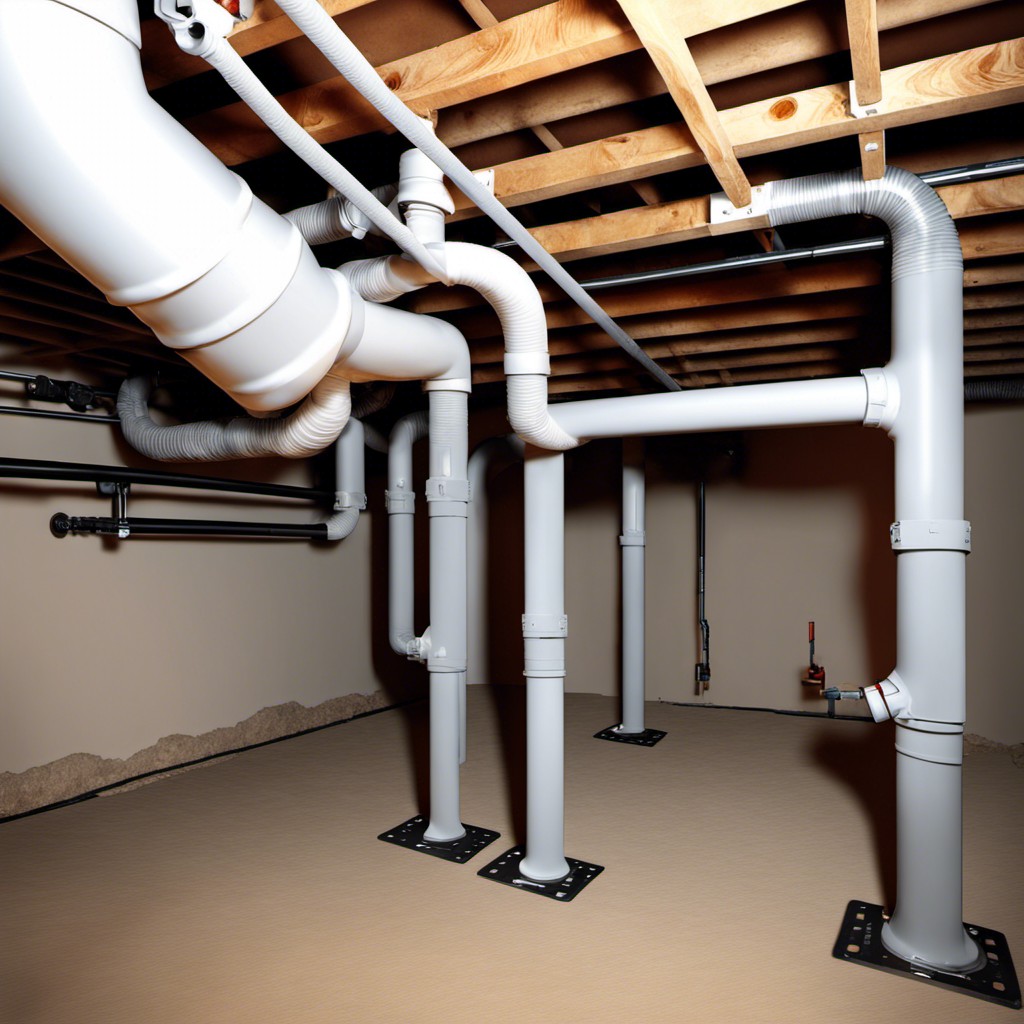
The SoFit system, a popular choice for concealing pipes, consists of pre-fabricated panels which are created using lightweight materials. These panels are then fitted around the pipes, providing a smooth, clean, and stylish facade that completely conceals your basement’s unsightly piping.
Here are some key points about the SoFit system:
- 1. It uses durable materials: The SoFit system uses sturdy materials like PVC or aluminum which can withstand the wear and tear of basement conditions.
- 2. It is a versatile system: The system can fit around a variety of pipe sizes and configurations, making it a versatile choice for many basements.
- 3. It can be customized: Beyond its functionality, the SoFit system can be painted or finished to match the style of your basement, seamlessly blending in with your chosen design aesthetic.
- 4. It’s a hassle-free installation process: The lightweight nature of the materials used in the SoFit system makes it easy to install, even for individuals with minimal DIY experience.
- 5. It’s an effective sound insulator: The SoFit system is not just about aesthetics. It also provides excellent sound insulation, reducing the noise emanating from your plumbing.
Do remember that while the SoFit system offers many advantages, choose it after considering the specific requirements of your basement.
PVC Casing
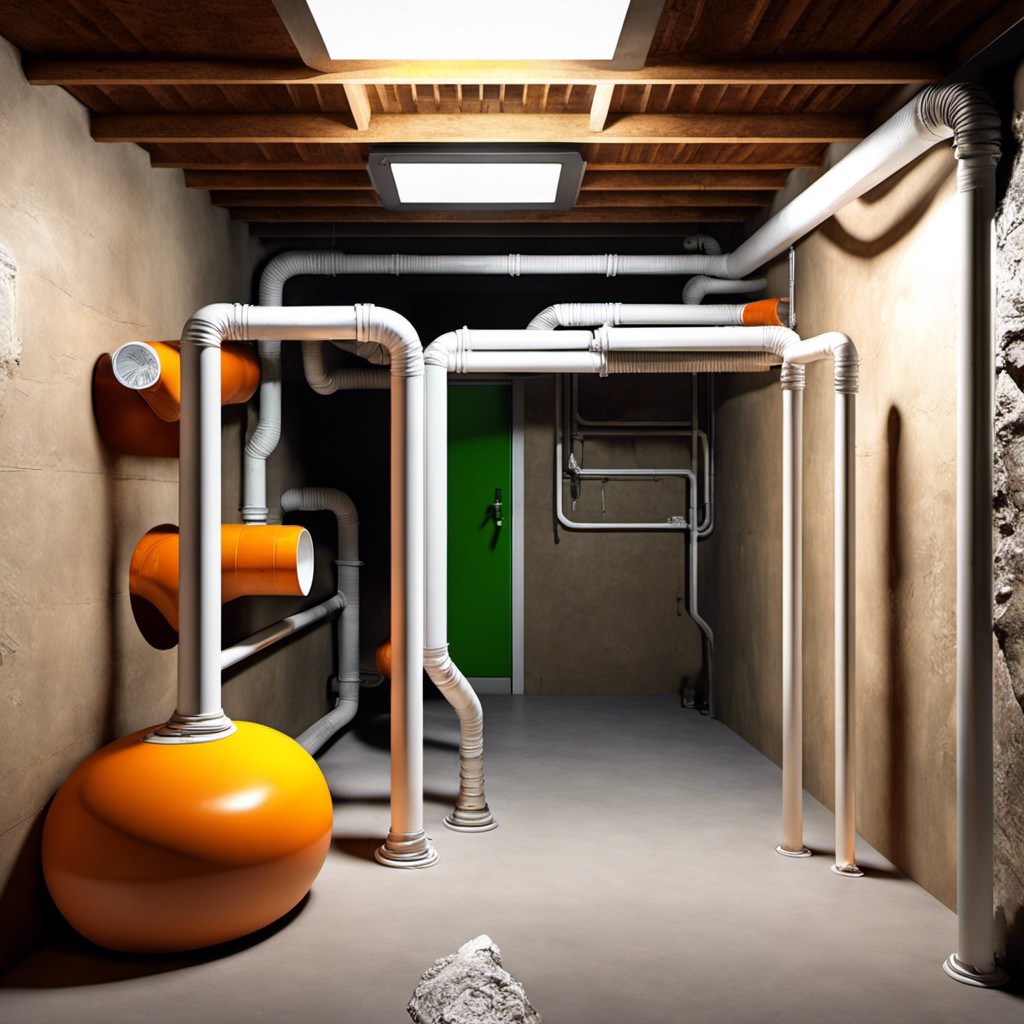
Using PVC casing presents a modern, clean, and cost-effective solution. It is durable, lightweight, and easy to work with.
Simply encase the pipes with custom-cut PVC sheets, securing them with adhesive or screws. This method not only conceals the pipes effectively but also allows for easy access for maintenance.
The casing can be painted or decorated to match your basement’s aesthetic, adding style and coherence to your overall décor. This option is especially suitable for water pipes, as PVC is highly resistant to moisture and corrosion.
In fact, it requires minimal maintenance, thus making it a long-lasting solution to cover up unsightly pipes.
Painted Piping

Choosing the right color can turn an unsightly pipe into a stylish decorative element, giving your basement a unique touch. When adhering to the aesthetics of your basement, select tones that blend with the existing color scheme.
Most commonly, homeowners go for shades of white, black or grey to maintain a minimalistic and clean look. A high-quality, heat-resistant paint is ideal for metal pipes, ensuring durability and longevity.
Alternatively, harness your creativity to make a bold statement by choosing bright or contrasting hues – transforming your piping into a piece of pop-art. This approach can add a playful spin to your basement, creating a fun conversation starter for guests.
Remember to prepare the pipe surface properly before applying paint. This includes cleaning, drying, and lightly sanding the surface to ensure optimal paint adherence and finished look. You must allow sufficient drying time between coats for the best outcome.
It’s crucial to note, however, that painting should be avoided in instances where pipes may routinely sweat, as this could potentially lead to a moisture problem down the line.
Decorative Panels
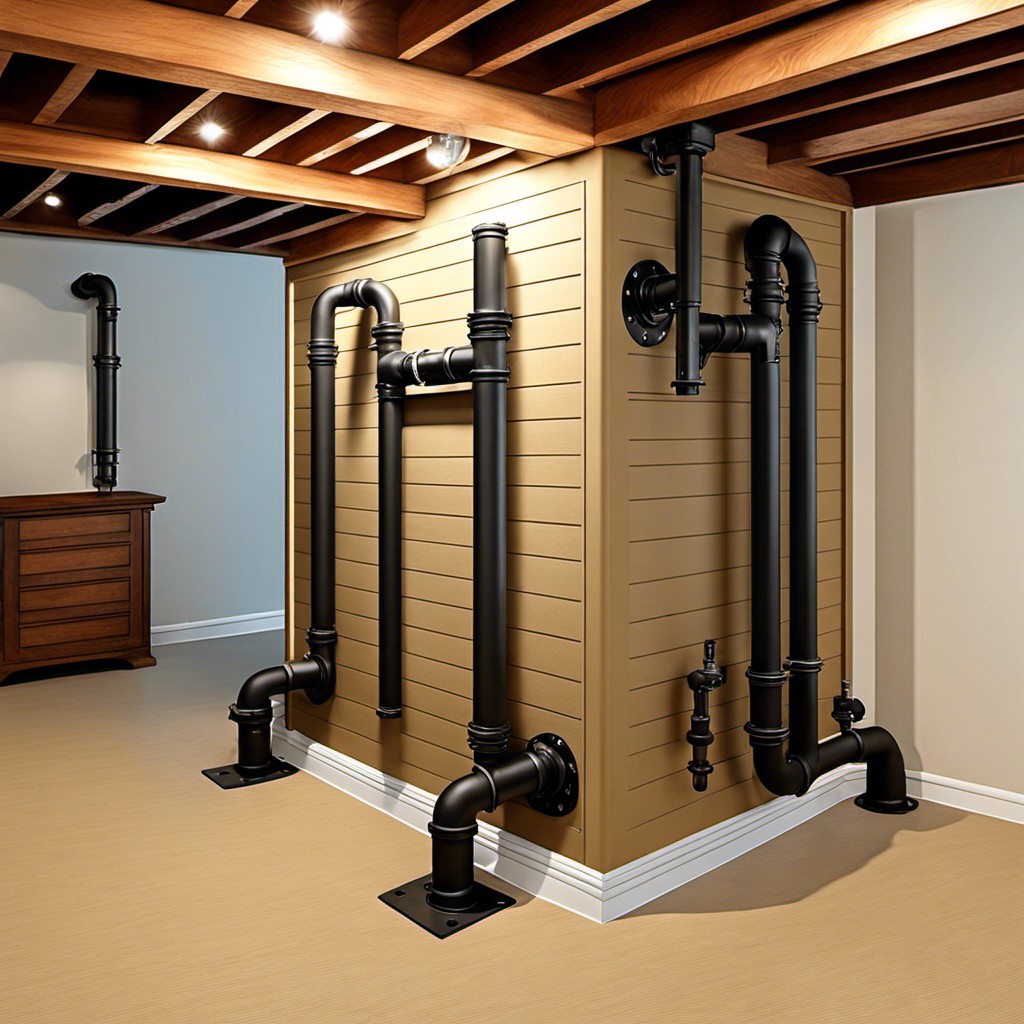
These eye-catching elements function as more than just a visual treat. Conveniently accessible, they offer the additional advantage of easy maintenance, as they can be removed for occasional inspections.
Suitable for various themes, they can be utilized to inject an element of character into your basement. Available in a variety of materials like fabric, wood, or metal, the panels can be chosen in styles ranging from ornate designs appealing to traditional sensibilities to minimalistic patterns for modern tastes.
Remember, the beauty of this method is that it doesn’t force you to compromise your basement’s aesthetics for functionality. Moreover, it provides an added bonus, acting as an extra layer of insulation for heat retention, reducing overall energy costs.
This two-in-one solution efficiently conceals unsightly pipework while simultaneously enhancing your living space’s overall ambiance.
Wood Paneling

Choosing the right kind of wood for paneling is crucial. Opt for a moisture and insect resistant variety like cedar or treated pine that is ideal for basements. Depending on your aesthetic preferences, paneling can be installed horizontally or vertically to visually elongate your space. Remember to treat and seal the wood before installing to reduce the likelihood of warping or damage due to basement dampness.
For a flexible, easy-to-install solution, consider snap-together wood panels that can be easily removed if needed. Paneling strips designed specifically for pipe coverage are also a great option – they’re versatile and can adapt to the unique curves and corners of your basement piping structure.
Finally, wood paneling not only covers unsightly pipes but also enhances the ambiance of your basement by adding a warm, natural element that can make your basement feel cozy and inviting. Whether you’re aiming for a rustic lodge feel or a modern, sleek finish – wood paneling offers a diverse range of options to cater to all design sensibilities. Remember, the finish you choose for your paneling can significantly influence your basement’s overall decor, so ensure it complements your style!
Wire Channeling
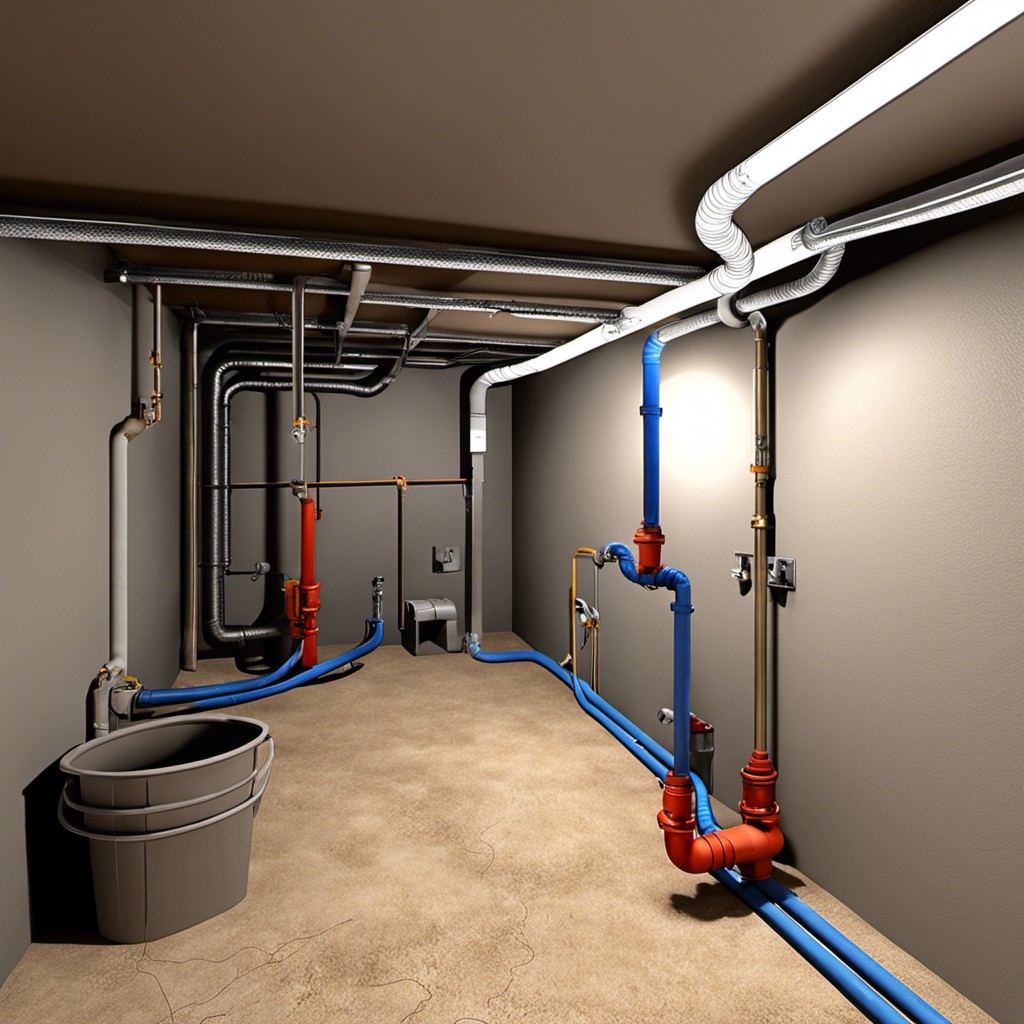
With wire channeling, your unsightly pipes gain a more orderly and professional appearance. This technique uses channels or conduit systems, readily available in hardware stores, crafted to store wiring or plumbing lines. They’re typically made from plastic or PVC and can be easily cut and installed to fit around your pipes.
While the standard color is white, they are paintable, enabling you to color match them to your basement decor for a more seamless aesthetic.
Apart from hiding pipes, these dedicated channels offer an additional layer of protection, shielding the pipes from potential damage or unwanted contact.
Pipe Wrap Insulation

Offering both a visual upgrade and practical benefit, this method beautifully conceals unsightly pipes while providing energy benefits. It uses specially designed wraps, offering an aesthetic solution as they come in a variety of colors. Their installation is accessible even to novice DIYers, using tools already found in most households.
The insulation also minimizes heat loss from hot water pipes and prevents condensation on cold water pipes. Its added advantage is the reduction of noise emanating from water traveling through the pipes. However, one must strategically place the wraps to avoid a cluttered look. Care should be taken during installation to ensure a secure, snug fit around pipes. This improves energy efficiency whilst maintaining a well-manicured basement appearance.
Basement Furniture Arrangement
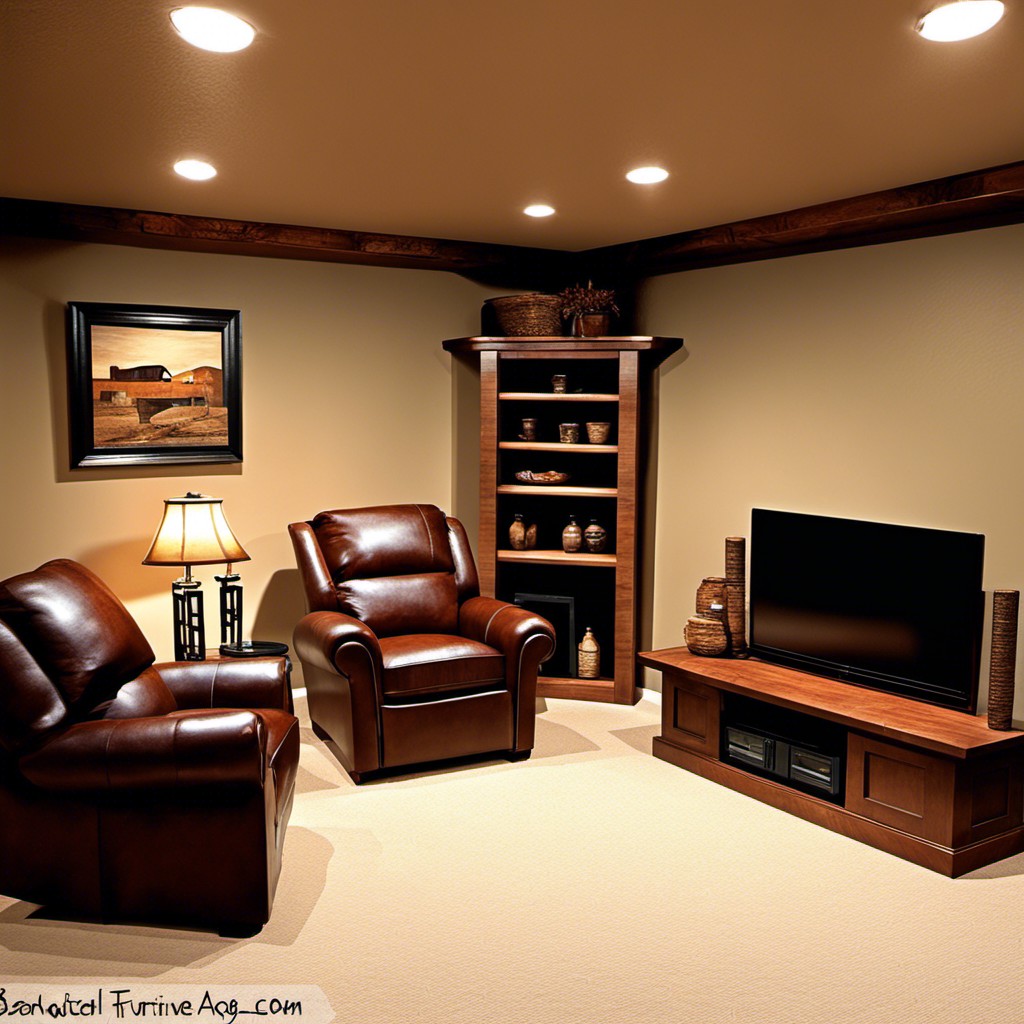
Utilizing furniture effectively lends a two-fold advantage; it serves its primary purpose and skillfully conceals unsightly pipes. Start with positioning large items such as sofas or entertainment centers against the piped walls. For added subtlety, choose furniture with high backs.
Modular shelving units can also be arranged creatively. They not only offer storage but can act as a disguise for obtrusions. Be sure not to block access to essential valves or pipe sections in case of maintenance needs.
Smaller pipes can be hidden behind decorative items like tall plants, standing lamps or large artworks. Capitalize on the vertical space, especially where plumbing lines run high along the wall. The strategic arrangement provides function, style, and practicality to your living space.
Creative Shelving

Using the vertical space around the pipes for shelving units offers a dual-purpose solution. Not only does this method mask the unattractive plumbing, but it also provides extra storage, ideal for small or cluttered basements. Make sure the shelves extend beyond the pipes, drawing the eye away from them.
- Utilize adjustable models to tailor the shelves according to the pipe layout.
- Implement open or closed shelving based on your style preference and storage needs.
- Consider features such as inbuilt lighting to accentuate the aesthetics and functionality of the area.
- Explore different materials, like wood or metal, and finishes to blend with the overall basement decor.
- Ensure the shelves are securely mounted to safely support your belongings.
Remember, uniformity is your ally, shelves should feel like an organic part of the room, not an afterthought. Create a design that harmonizes with your existing decor style for an appealing and practical basement makeover.
Curtain Dividers

Exploring beyond traditional methods can lead to ingenious solutions, and that’s where our journey takes us now to Curtain Dividers. Considering their versatility and cost-effectiveness, these make an excellent choice for seamlessly masking pipes.
Installing curtain dividers can be relatively easy and doesn’t require much financial investment or labor. Having the freedom to choose from endless fabric styles and patterns allows for a high degree of personalization. Besides hiding unsightly pipes, they can also serve as soft, aesthetic backdrops adding character to the basement.
Curved tracks installed along the ceiling allow for flexibility in revealing or hiding the pipes behind the curtain as needed. For transparency, opt for non-combustible materials to ensure safety. A key point to remember is to measure the height from ceiling to floor meticulously before choosing the curtain length.
Remember, it’s about balancing functionality and aesthetics. And in no time, you’ll have turned a liability into a design asset with a simple, tailored curtain divider.
Suspended Storage
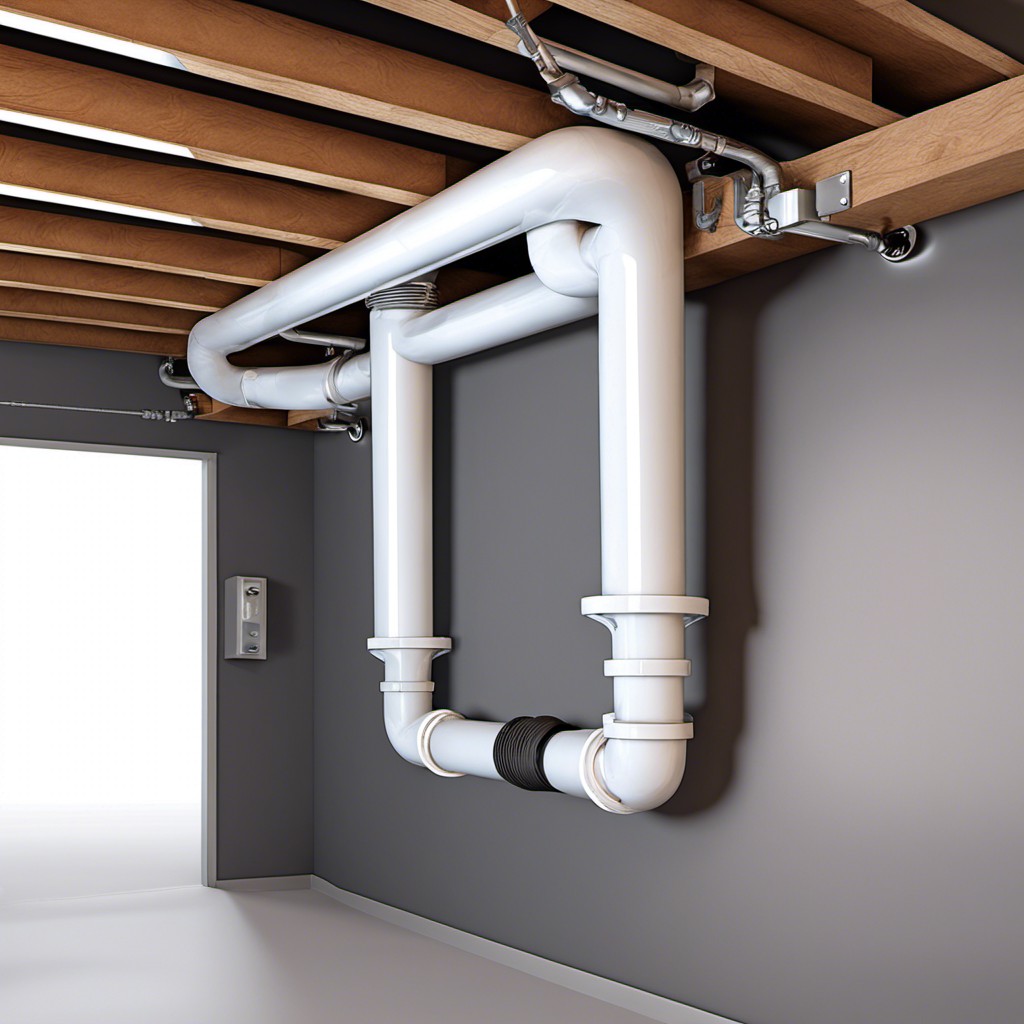
Taking advantage of the vacant space above, suspended storage serves an aesthetic and functional role. Ideal for basements bustling with activity, this method cleverly diverts attention from the less attractive features. Pipes blend into the background as vibrant, suspended shelving or hanging bins catch the eye.
Here are some key points:
- 1. Versatility: Fit for any basement regardless of size or shape. Customizable to suit personal needs and tastes.
- 2. Space Maximization: It utilizes overhead space, leaving more room for movement and activities at ground level.
- 3. Cost-Effective: Can be implemented using common household items like wooden crates or metal baskets.
- 4. Easy Access: Items are visible and readily at hand, eliminating the need for tedious rummaging.
- 5. Conceal and Reveal: A tactful way to draw attention to colorful containers and away from piping.
In essence, suspended storage artfully marries utility with design, effortlessly concealing pipes.
Chalkboard Wall
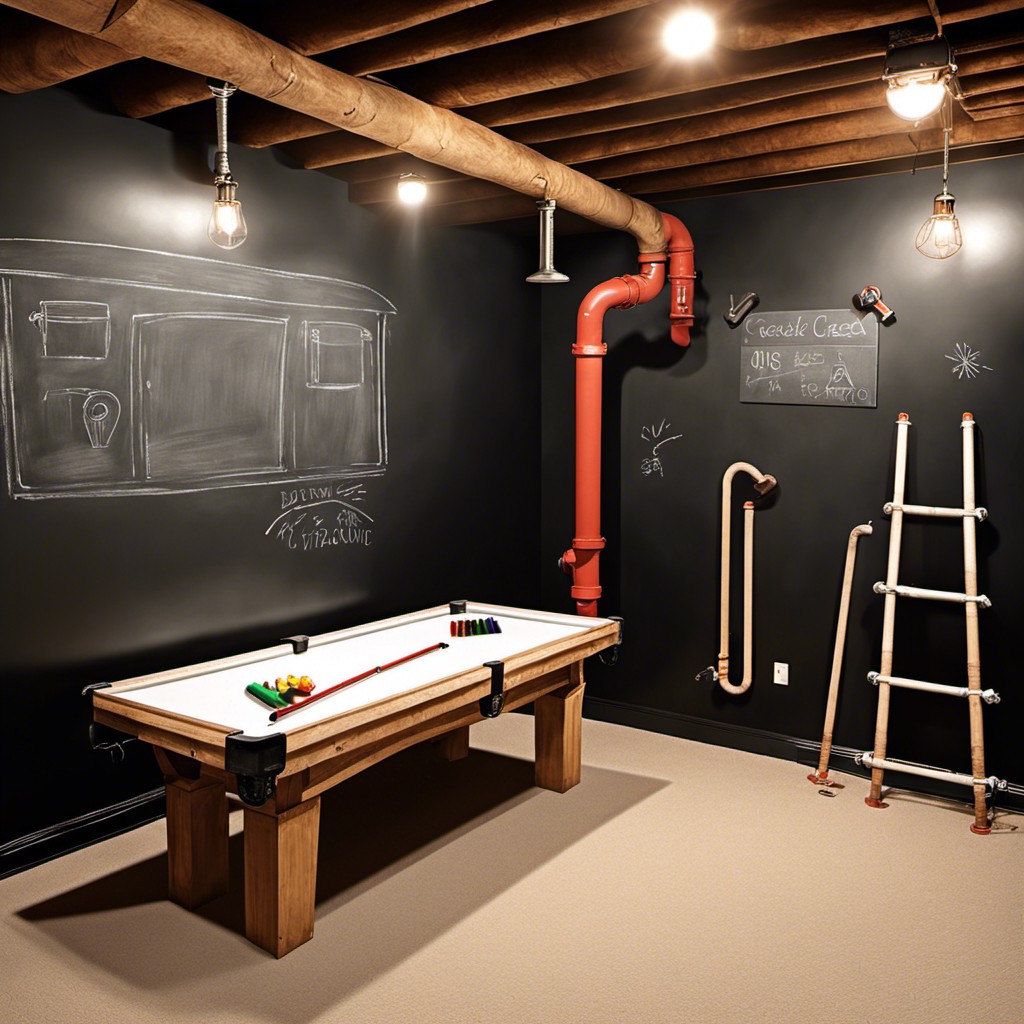
Implementing the chalkboard wall concept is an innovative and functional solution, appealing to both your décor preferences and practical needs. This simple DIY project not only masks ugly pipes but also serves many purposes. Here’s why:
1. Versatility: No more unsightly pipes or dull walls. This unique practical artwork offers a refreshing change of pace. From personal notes to children’s doodles, it’s an ever-evolving wall of creativity.
2. Camouflage: Dark chalkboard paint is perfect to seamlessly blend in darker pipes. It’s also a great way to fix minor imperfections on your basement walls.
3. Space utilization: The chalkboard serves as a great place for grocery lists, reminders, or even a space for the kids to draw and color. Reclaim your fridge door by shifting that clutter here.
4. Easy to implement: Be prepared to paint a couple of coats for best results, but it’s a relatively minor effort for a significant improvement.
Remember to leave a little space between the chalkboard paint and your wall to ensure the pipes do not heat up the chalkboard painted wall. Moreover, if your pipes commonly sweat, this may not be a feasible option. Always keep safety as a priority.
Bamboo Screening
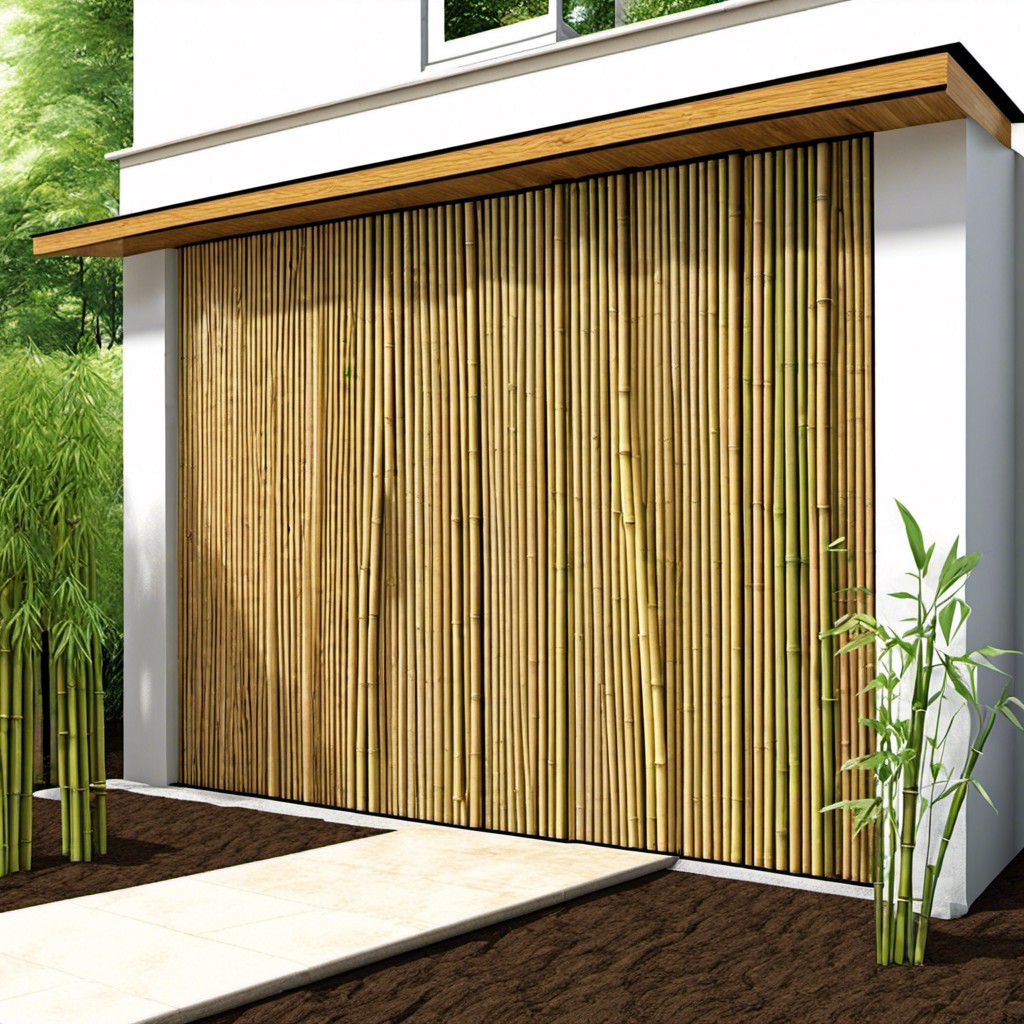
For an eco-friendly and aesthetically pleasing option, bamboo screening can serve as a great way to disguise unsightly pipes. Attached to a supporting frame, these mats offer an appealing visual element while subtly masking underlying infrastructure.
This approach offers numerous benefits:
- Aesthetics: Bamboo screening brings an organic, warm, and natural touch to the basement, therefore enhancing its overall ambiance.
- Flexibility: As a material, it can be easily trimmed or resized to match the specific area, allowing a seamless fit.
- Sustainability: Bamboo is a rapidly renewable resource which makes this option an environmentally conscious one.
- Easy Installation: Often sold as rolled-up mats, bamboo screening can be easily hung up using simple tools.
Remember, adequate ventilation should be accounted for in the design to prevent condensation and any potential damage to either the pipes or the bamboo.
Built-in Bookshelves
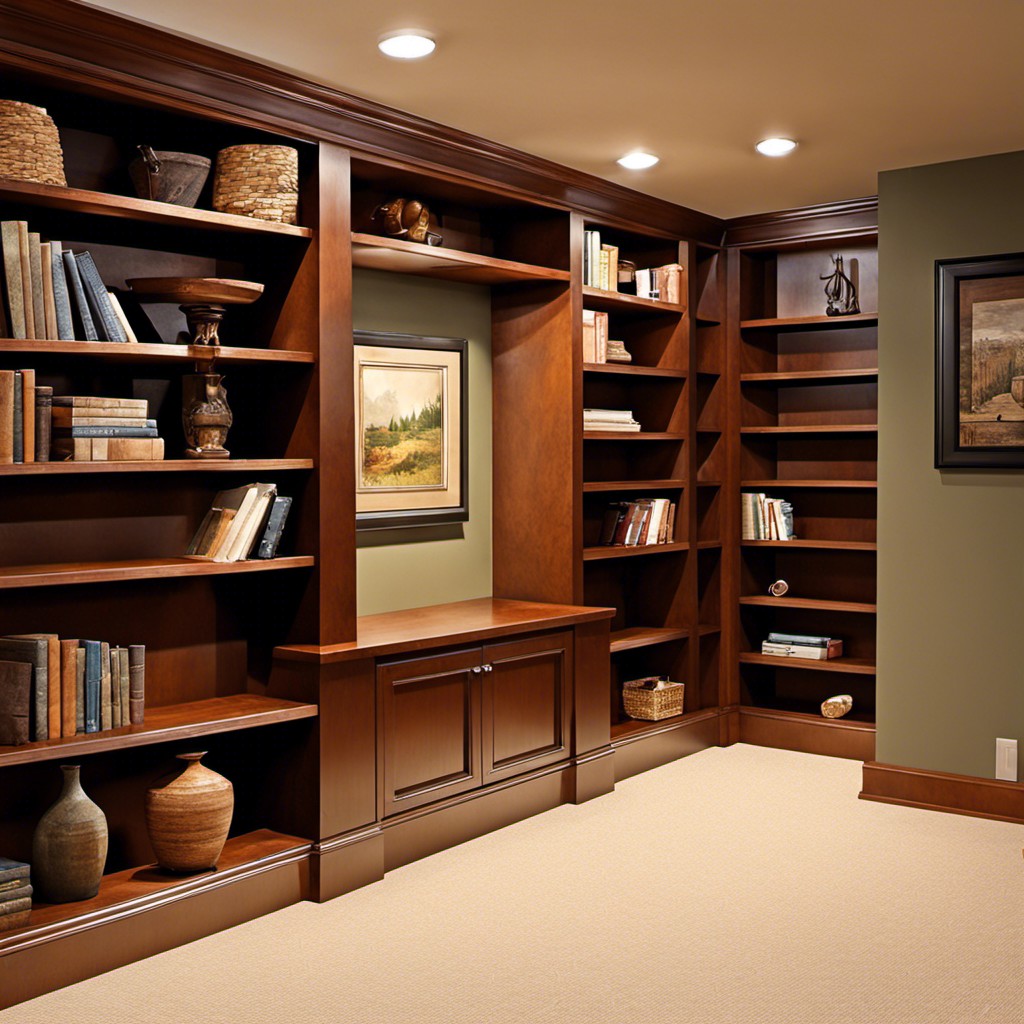
Seamlessly integrating these functional structures into your basement decor not only adds aesthetic value, but also serves as an excellent disguiser for any unsightly pipes. Built-in bookshelves provide ample storage for your various collections, from books to memorabilia, eliminating clutter and creating a clean, composed environment. Adaptable to virtually any basement size or layout, these fixture’s depth and height can be customized to completely hide pipes behind them.
Here are some engaging ways to use built-in bookshelves:
- 1. Highlight Artwork: Showcase your favorite pieces or family portraits on the shelves, drawing the eye away from any exposed piping.
- 2. Create a Reading Nook: Pair your bookshelves with a comfortable chair and a floor lamp for a snug reading corner.
- 3. Display Collectibles: Whether you love vintage trinkets or sports memorabilia, bookshelves can provide a great display space.
- 4. Add Doors: Adding doors to the lower section of the bookshelves can provide extra hidden storage, perfect for board games or seasonal decor.
- 5. Use Lighting: Incorporate focused lighting to highlight the contents of the shelves and add a welcoming ambiance to the space.
- 6. Color Coordinate: Painting your shelves the same color as the wall can give a streamlined, modern look and draw less attention to the area.
Always remember, your personal touches will make these built-in book shelves a successful disguise for any pipes, while enhancing the overall feel of your basement. These creative ideas not only serve a practical purpose but also add charm and character to your space.
Industrial Chic Design

Embracing the exposed pipework is at the heart of the Industrial Chic Design. This concept is about turning a perceived flaw into a striking design element. Here’s how to achieve this look:
1. Metallic Finishes: Spruce up your pipes with high gloss metallic paint. A silver or copper finish can add a modern twist to the raw industrial aesthetic.
2. Light Fittings: Consider installing vintage light fixtures that hang along the pipe pathway. Edison style bulbs offer an attractive touch.
3. Hanging Decor: Make use of the pipes to hang decor elements, such as pendant lights, plants, or artwork. This can help enhance the industrial style.
4. Compatible Furnishings: Opt for furniture pieces that affirm the industrial vibe, such as those made from metal, or recycled wood. Leather furnishings also complement this style well.
5. Brickwork: A brick wall backdrop can accentuate the industrial feel. If you don’t have a natural brick wall, there are wallpapers available that mimic this look convincingly.
6. Area Rugs: Soften the harsh edges of the industrial chic theme and add warmth to the space with area rugs preferably with geometric patterns.
Remember, the aim is not to disguise but to highlight the pipes subtly, making them a part of your overall decor scheme.
Pipe Enclosure Kits
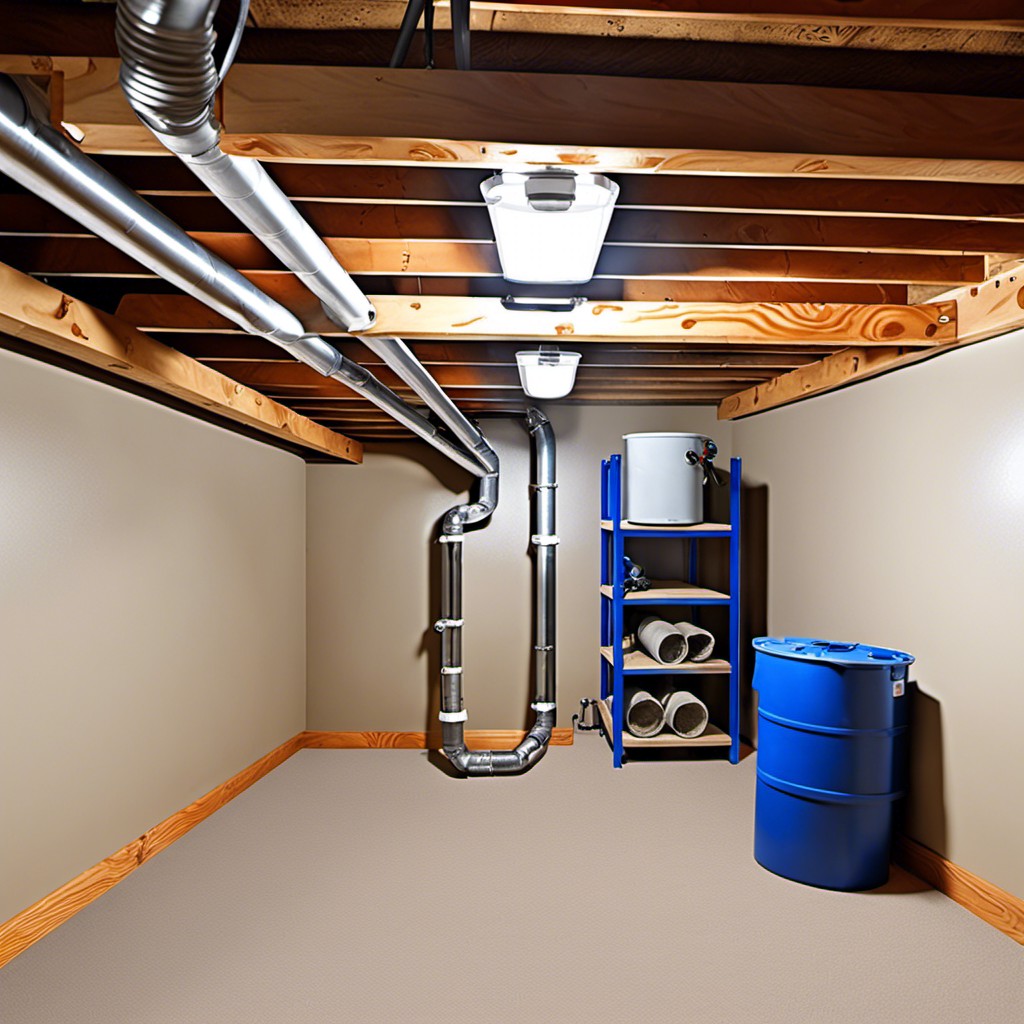
Pipe enclosure kits present a convenient off-the-shelf solution for concealing exposed basement pipes. These kits come with all the necessary components, including brackets, screws, and covers prepared to simply fit together. They not only streamline the whole hiding process but offer flexibility in design options.
Available in various sizes and materials, pipe enclosures can be selected to match the existing basement décor. Materials often range from plastic, metal to even faux wood, bringing diverse aesthetics to the environment. Choosing kits with insulation can boost energy efficiency by preventing heat loss in exposed pipes.
Installation typically doesn’t require extensive professional knowledge. Keep in mind to occasionally remove and check for any leaks or repairs needed to maintain the integrity of the pipe system.
Ceiling Clouds
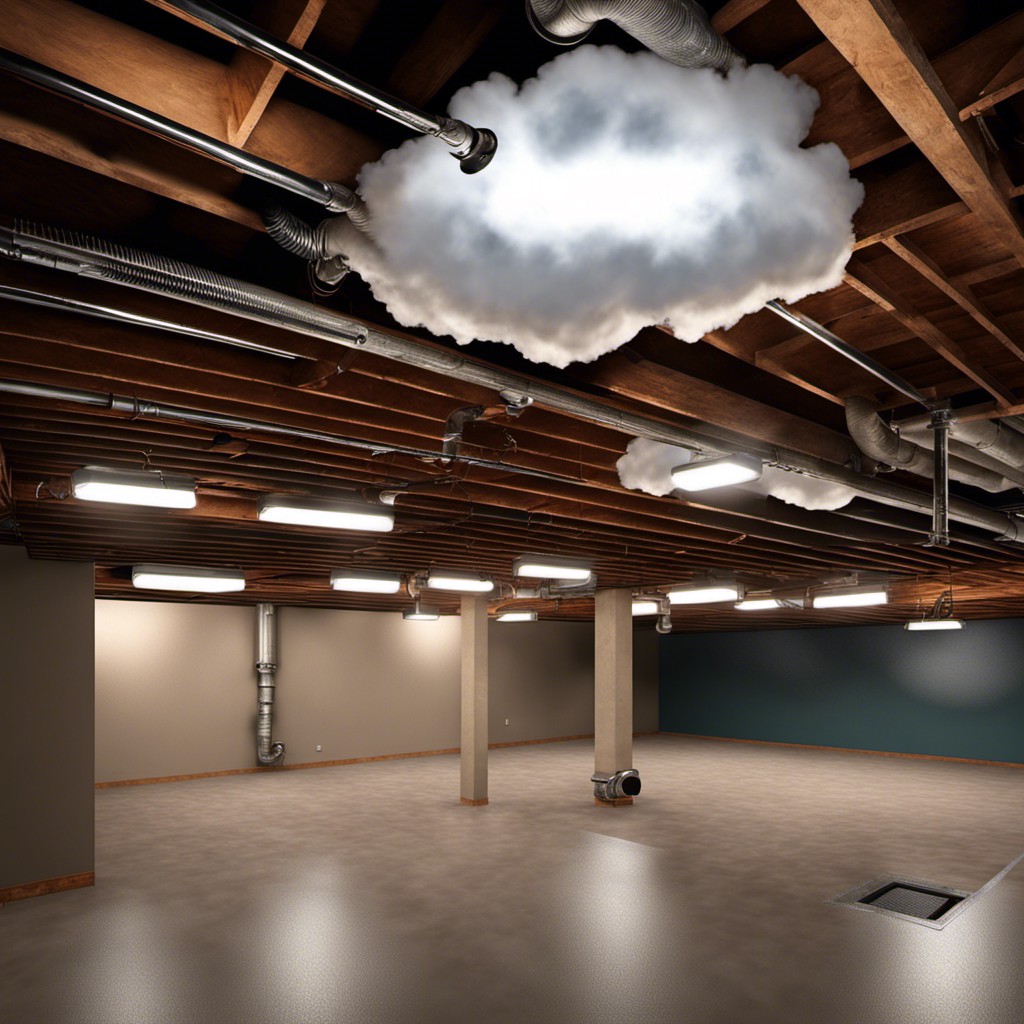
Ceiling clouds offer a remarkable blend of function and aesthetics. Named for their floating appearance, they’re essentially groups of acoustic panels suspended from the ceiling, creating an attractive structure that obscures unsightly pipes.
Besides their aesthetic appeal, they have a practical side. They help absorb sound, making your basement quieter and more acoustically pleasant.
To achieve a seamless look, consider matching the color and texture of the clouds to the existing room decor. This can be particularly effective in a basement with a high ceiling, as it diverts attention away from unfinished areas and pipes, focused instead on the finished, furnished area below.
Installation might require some expertise, so don’t hesitate in hiring a professional. It’s a unique, visually interesting solution well worth considering.




